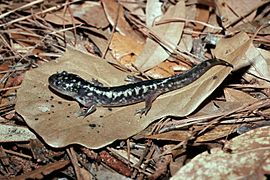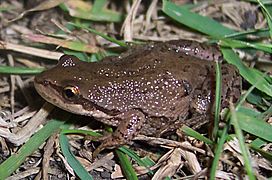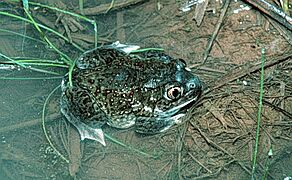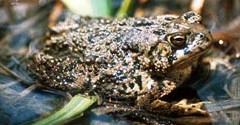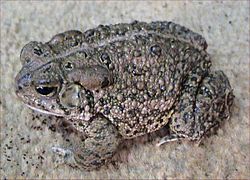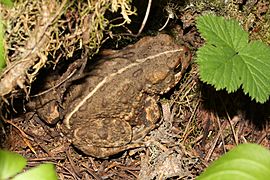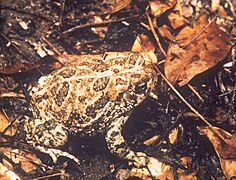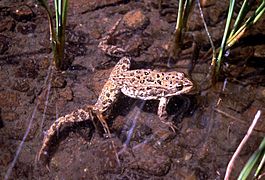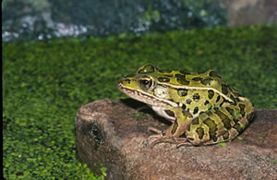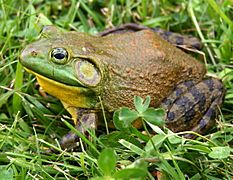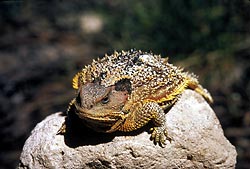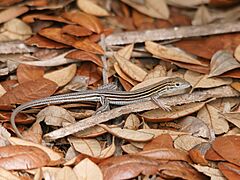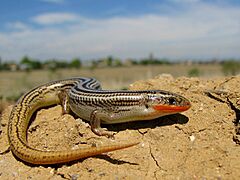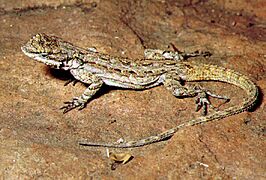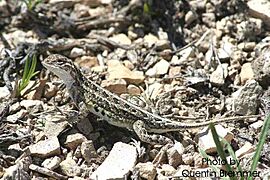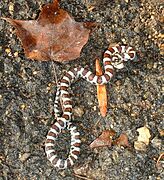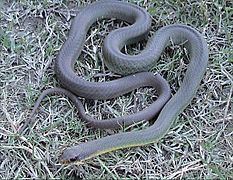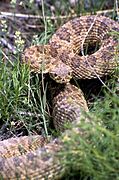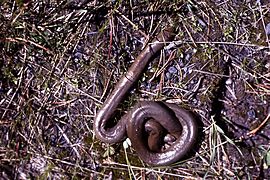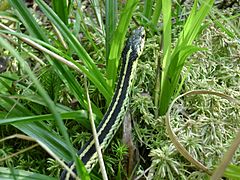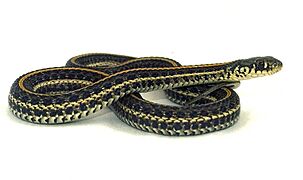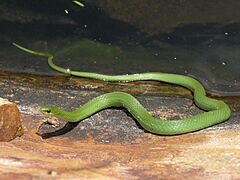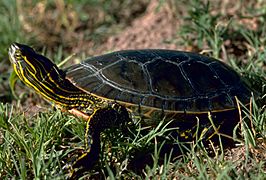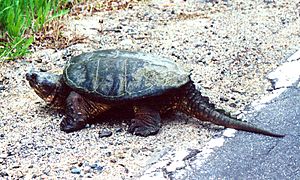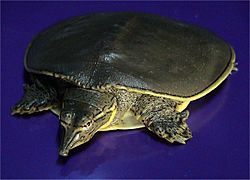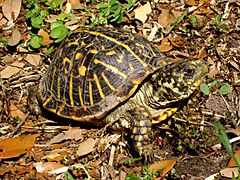Amphibians and reptiles of Wyoming facts for kids
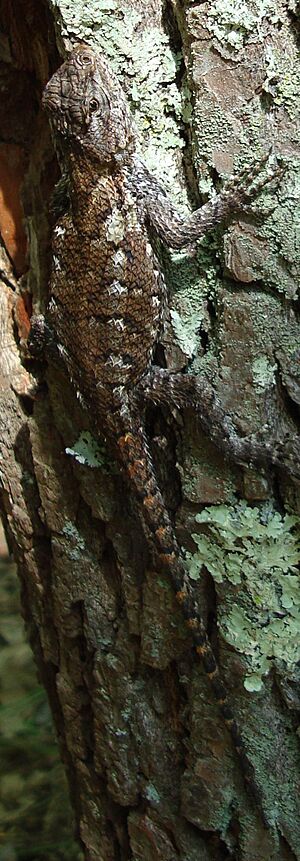
Wyoming is home to many amazing creatures! You can find 12 different types of amphibians and 22 kinds of reptiles living here.
Contents
- Amphibians
- Reptiles
- Prairie Racerunner
- Common Sagebrush Lizard
- Mountain Short-horned Lizard
- Eastern Fence Lizard
- Many-lined Skink
- Cliff Tree Lizard
- Great Plains Earless Lizard
- Gophersnake
- Milk Snake
- Prairie Rattlesnake
- Rubber Boa
- Plains Garter Snake
- Common Garter Snake
- Terrestrial Garter Snake
- Eastern Racer
- Smooth Greensnake
- Black Hills Red-bellied Snake
- Western Hog-nosed Snake
- Snapping Turtle
- Spiny Softshell
- Ornate Box Turtle
- Western Painted Turtle
Amphibians
Amphibians are cool animals that can live both in water and on land. They start their lives in water and then change as they grow. In Wyoming, you can find many different frogs, toads, and salamanders.
Tiger Salamander
The tiger salamander is a large salamander. They usually grow to be 6 to 8 inches long. Some can even reach up to 14 inches! They often have blotchy patterns of gray, green, or black.
Tiger salamanders eat small insects and worms. Sometimes, bigger ones might even eat small frogs or baby mice. In Wyoming, you can find them near still water, which they need for breeding.
Boreal Chorus Frog
The boreal chorus frog is a small frog, only about 1.2 inches long. They are usually brown, but can also be green. They have three broken stripes on their backs. A dark stripe runs from their nose, through their eye, and down their side.
These frogs have slightly bigger toe pads. This helps them climb small plants. In Wyoming, they live in marshes, ponds, and small lakes. They can be found up to 12,000 feet high!
Great Basin Spadefoot Toad
The Great Basin spadefoot is a type of toad. They live in many different places. These include forests, shrublands, grasslands, and even deserts. They can also be found in farm areas.
In Wyoming, you can find this toad in sagebrush areas. They live below 6,000 feet, west of the Continental Divide.
Plains Spadefoot Toad
The plains spadefoot toad gets its name from a special "spade" on its back legs. This spade helps them dig into sandy soil. These toads are usually 1.5 to 2.5 inches long. They have round bodies and short legs.
Their color can be gray or brown, matching the soil where they live. In Wyoming, they are found in grasslands and sagebrush areas. They live below 6,000 feet, east of the Continental Divide.
Western Toad
The western toad is a large toad. It can be 2 to 5 inches long. It has a white or cream stripe down its back. Its skin is usually dusky gray or greenish. Dark spots on its back have glands that produce a mild toxin.
In Wyoming, these toads live in wet areas. You can find them in foothills, mountains, and subalpine zones. They are usually found between 8,000 and 11,000 feet high.
Woodhouse's Toad
Woodhouse's toad is a medium-sized toad, about 4 inches long. It is found in the United States and Mexico. In Wyoming, these toads live in floodplains. They need permanent water or irrigation runoff.
You can find them in plains and foothills east of the Continental Divide. They usually live below 6,000 feet.
Great Plains Toad
The Great Plains toad is a fairly large toad. It can grow to be 2 to 4.5 inches long. It is gray, brown, and green with darker blotches. Its main food is cutworms.
This toad likes grasslands with loose soil for burrowing. It often breeds after heavy rain. In Wyoming, it lives in plains grasslands, sandhills, and farm areas. It is found below 6,000 feet.
Wyoming Toad
The Wyoming toad is very rare. It only lives in captivity and in the Mortenson Lake National Wildlife Refuge in Wyoming. This toad was listed as an endangered species in 1984. It has been considered extinct in the wild since 1991.
American Bullfrog
The American bullfrog is a large water frog. It is native to North America. These frogs live near big, permanent water bodies. You can find them in swamps, ponds, and lakes. They usually stay along the water's edge.
On rainy nights, bullfrogs might travel over land. In Wyoming, they live near permanent water. They are found below 6,000 feet on the eastern plains.
Columbia Spotted Frog
The Columbia spotted frog is a medium-sized frog. It can grow up to 3.5 inches long. Its color ranges from dark olive green to light brown. It has black spots on its back and legs. Its belly and upper lip are white.
These frogs spend most of their time in water. They have more webbing on their back feet than other similar frogs. In Wyoming, they live in ponds, sloughs, and small streams. You can find them in foothills and mountain zones.
Northern Leopard Frog
The northern leopard frog is a fairly large frog, about 4.3 inches long. It can be green or brown. It has large, dark circular spots on its back, sides, and legs. These frogs live in many different places.
They are found in ponds, swamps, and slow-moving streams. They like water with lots of plants. They can live in cold places, even above 9,800 feet. In Wyoming, they live in swampy marshes and beaver ponds. They are found in plains, foothills, and mountain zones up to 9,000 feet.
Wood Frog
The Wood frog lives across a large part of North America. In Wyoming, this frog is found in beaver ponds, small lakes, and slow-moving streams. It also lives in wet meadows and willow thickets. You can usually find it in mountain areas, around 9,000 feet high.
Reptiles
Reptiles are cold-blooded animals with scales. They include lizards, snakes, and turtles. Wyoming has many different kinds of reptiles, each with unique features!
Prairie Racerunner
The six-lined racerunner is a type of lizard. It is found across the Great Plains of the United States. In Wyoming, you can find this lizard in plains grasslands and sandhills. They also live along sandy or gravelly streambanks.
Common Sagebrush Lizard
The sagebrush lizard is a common lizard in the Western United States. It is named after the sagebrush plants where it often lives. This lizard has rough, spiny scales on its back.
In Wyoming, you can find it on rocky areas in sagebrush and juniper lands. They usually live below 6,000 feet. You can even find them near hot springs in Yellowstone National Park at 7,500 feet!
Mountain Short-horned Lizard
The mountain short-horned lizard is a lizard that is active during the day. It mainly eats ants, but will also eat young snakes. These lizards are found in mountain ranges across the western U.S. and into Canada. They can live from sea level up to over 10,000 feet high.
In Wyoming, this lizard lives in grasslands and sagebrush-grasslands.
Eastern Fence Lizard
The eastern fence lizard is a medium-sized lizard. It lives along forest edges, rock piles, and rotting logs. In Wyoming, there are different types of this lizard. One type, the northern plateau lizard, lives on rock outcrops and canyon walls. Another type, the Red-lipped Plateau lizard, is found on rock cliffs in specific counties. The Northern Prairie lizard lives in sandy areas with low shrubs or on sandstone outcrops.
Many-lined Skink
The many-lined skink is a medium-sized lizard. It lives in North America. In Wyoming, this lizard is found in grassland areas and woodlands. It usually hides under things like flat rocks or boards. It prefers sandy soil and lives below 5,500 feet.
Cliff Tree Lizard
The tree lizard or ornate tree lizard is a lizard native to the southwestern United States and northern Mexico. In Wyoming, one type of this lizard lives on cliffs and rocky canyon slopes. You can find them in sagebrush desert areas.
Great Plains Earless Lizard
The lesser earless lizard is a lizard found in the southwestern and central United States and northern Mexico. In Wyoming, one type of this lizard lives in plains grassland areas. They like places with yucca plants and open sandy spots.
Gophersnake
The gophersnake or bullsnake is a large, non-venomous snake. It is common in the central United States, northern Mexico, and southern Canada. In Wyoming, the bullsnake lives in many different places. These include plains grasslands, sandhills, and rocky canyons. You can even find them in farm areas and cities. Another type, the Great Basin Gophersnake, lives in sagebrush and desert areas.
Milk Snake
The milk snake is a type of king snake. There are many different kinds of milk snakes, and they look very different from each other. They can grow from 20 to 60 inches long. They are found from Canada, through most of the United States, and into Central and South America.
In Wyoming, one type of milk snake, the pale milksnake, lives in grasslands, sandhills, and woodlands. They are usually found below 6,000 feet.
Prairie Rattlesnake
The prairie rattlesnake is a venomous snake. It is native to the western United States, southwestern Canada, and northern Mexico. In Wyoming, this snake lives in plains, foothills, and woodlands. They especially like areas near granite or limestone rocks.
Another type, the midget faded rattlesnake, lives in rocky areas in sagebrush deserts. Its home is only in the lower Green River Valley.
Rubber Boa
The rubber boa is a non-venomous snake. It belongs to the boa family. In Wyoming, this boa lives near water. You can find it hiding under logs, flat rocks, and other things on the ground. They live in the foothills and lower mountain areas.
Plains Garter Snake
The plains garter snake is a type of garter snake. It has a bright orange or yellow stripe from its head to its tail. The rest of its body is usually gray-green. These snakes often live near water, like streams and ponds. You can also find them in cities and empty lots.
In Wyoming, this snake lives near small streams, marshes, and ponds. It can also be found in dry grasslands and sandhills.
Common Garter Snake
The valley garter snake is a type of common garter snake. It is native to North America. Most garter snakes have yellow stripes on a brown background. They are usually 3 to 5 feet long. These snakes are active during the day. In summer, they are most active in the morning and late afternoon.
In Wyoming, this snake lives in plains, foothills, and mountain zones. They are usually found near permanent water sources. Another type, the Red-sided Gartersnake, lives near marshes, ponds, and small streams.
Terrestrial Garter Snake
The wandering garter snake is a type of western terrestrial garter snake. Most of these snakes have a yellow, light orange, or white stripe down their back. They also have two stripes on their sides. Some have red or black spots. This snake often lives in pine forests and likes water.
In Wyoming, this snake lives in almost all habitat zones, except very high mountains. They are usually found near water.
Eastern Racer
The eastern racer is a non-venomous snake. They are found across the United States, east of the Rocky Mountains. They also live north into Canada and south into Mexico. Racers usually grow to about 3.5 feet long, but some can reach 6 feet! Their colors vary, but they are often solid black, brown, blue, or green.
In Wyoming, one type of eastern racer lives in woodlands within the plains and foothills. They are often found near water.
Smooth Greensnake
The smooth green snake is a non-venomous snake found in North America. It is also called a grass snake. This snake is bright green. It mainly lives in moist meadows, prairies, and clearings in forests. They mostly eat insects like crickets, grasshoppers, and caterpillars.
In Wyoming, this snake hides under rocks, logs, or other things on the ground. They live in forests within the foothills and mountain zones. They are usually found where there is lots of green plant life.
Black Hills Red-bellied Snake
The red-bellied snake is a very small snake. It is brown or gray with faint stripes. Its belly is red, pink, or orange. Adults are usually 8 to 16 inches long. These snakes live in fields and woods. They are often found under boards or other objects at the edges of lumber piles. They eat worms, slugs, and snails.
In Wyoming, one type of this snake lives near water. You can find it under flat rocks, logs, and other things in moist woodlands.
Western Hog-nosed Snake
The western hog-nosed snake is a harmless snake found in North America and northern Mexico. It is light sandy brown with darker blotches. Its belly often has a black and white or yellow checker pattern. These snakes are stout and can grow from 15 to 33 inches long. Females are usually bigger.
All hog-nosed snakes have an upturned snout. This helps them dig in the soil. In Wyoming, one type of this snake lives in burrows in soft soil or sand. You can find them in plains grasslands and sandhills.
Snapping Turtle
The common snapping turtle is a large freshwater turtle. It lives from southeastern Canada, through the United States, and south to Ecuador. These turtles are widely known as "snapping turtles."
In Wyoming, this turtle lives in permanent lakes, ponds, and large streams. They are found below 6,000 feet.
Spiny Softshell
The spiny softshell turtle is one of the largest freshwater turtles in North America. It gets its name from the spiny bumps on the front edge of its shell. These are not scales. The spiny softshell lives across much of the United States, Canada, and Mexico.
In Wyoming, one type of this turtle lives in permanent lakes, ponds, and large streams. They are found below 6,000 feet.
Ornate Box Turtle
The ornate box turtle is one of only two land turtles native to the Great Plains of the United States. It is a relatively small turtle. While not endangered, it is protected in some Midwestern states.
In Wyoming, this turtle lives in grasslands and sandhills. It is found in Goshen County.
Western Painted Turtle
The painted turtle is the most common native turtle in North America. It lives in slow-moving fresh waters. You can find it from southern Canada to Louisiana and northern Mexico, and from the Atlantic to the Pacific coasts.
In Wyoming, one type of this turtle lives in permanent ponds, reservoirs, marshes, and slow-moving streams. They are found below 6,000 feet.


